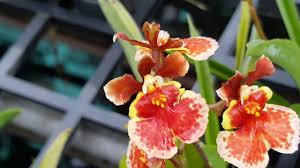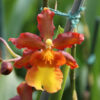# A Comprehensive Guide to Designing a Phalaenopsis Orchid Garden for Small Spaces

Creating a beautiful and serene garden featuring Phalaenopsis orchids (commonly known as moth orchids) in a limited space can be a rewarding and fulfilling project. With their stunning blooms and diverse colors, these orchids can transform even the smallest areas into lush and vibrant environments. This guide will provide you with a step-by-step approach to designing a Phalaenopsis orchid garden tailored for small spaces, covering everything from site selection to care and maintenance.
## 1. Understanding Phalaenopsis Orchids
### 1.1 Overview of Phalaenopsis Orchids
Phalaenopsis orchids are one of the most popular types of orchids due to their striking flowers and ease of care. They come in a wide range of colors and patterns, making them perfect for decorative purposes. Understanding their basic needs and characteristics is essential for successful cultivation.
### 1.2 Characteristics of Phalaenopsis Orchids
– **Growth Habit**: These orchids are epiphytic, meaning they grow naturally on other plants or trees in their native habitats, usually tropical regions. They prefer humid environments with filtered light.
– **Watering Needs**: Phalaenopsis orchids require regular watering but should never sit in standing water. The potting medium should dry out slightly between waterings.
– **Light Requirements**: They thrive in bright, indirect sunlight. Too much direct sunlight can scorch the leaves, while too little can hinder blooming.
## 2. Designing a Small Orchid Garden
Designing an orchid garden in a small space involves careful planning and consideration of various factors, including layout, plant selection, and environmental conditions.
### 2.1 Assessing the Space
Before you begin designing your garden, evaluate the space you have available. Whether it’s a small balcony, patio, or even a corner of a room, consider the following:
– **Size**: Measure the dimensions of the area to understand how many plants you can fit without overcrowding.
– **Light Availability**: Observe the amount of natural light the space receives throughout the day. This will help you determine the best locations for your orchids.
– **Climate**: Consider the local climate and how it may affect the growing conditions for your orchids.
### 2.2 Choosing the Right Containers
Containers play a significant role in the health of your Phalaenopsis orchids. When selecting pots, consider:
– **Material**: Terracotta, plastic, and ceramic pots are popular options. Terracotta pots allow for better airflow, while plastic pots retain moisture better.
– **Drainage**: Ensure that the containers have drainage holes to prevent waterlogging, which can lead to root rot.
– **Size**: Choose pots that are slightly larger than the root ball of the orchid. Overly large pots can retain excess moisture, leading to root problems.
### 2.3 Selecting a Suitable Potting Medium
The potting medium is crucial for the health of Phalaenopsis orchids. A good mix should allow for adequate drainage and airflow. Recommended options include:
– **Orchid Bark Mix**: A combination of pine bark, charcoal, and perlite provides excellent drainage and aeration.
– **Coconut Coir**: This organic material retains moisture while allowing for good drainage.
– **Sphagnum Moss**: Often used for moisture retention, it can be mixed with bark for added aeration.
## 3. Planning the Layout
Creating an aesthetically pleasing layout is essential in a small garden. Here are some tips for designing your Phalaenopsis orchid garden:
### 3.1 Vertical Gardening
Utilizing vertical space is an effective way to maximize your garden area. Consider the following:
– **Shelves and Stands**: Install shelves or plant stands to display multiple orchids at different heights. This not only saves space but also adds visual interest.
– **Wall-mounted Planters**: Use wall-mounted planters or pocket gardens to create a living wall of orchids. These can be particularly effective in small areas.
### 3.2 Grouping and Arranging Plants
Group your Phalaenopsis orchids according to their light and water requirements. Here are some arrangement ideas:
– **Color Coordination**: Arrange orchids by color for a cohesive look. Group similar colors together to create a stunning visual effect.
– **Height Variation**: Mix plants of varying heights to create depth and dimension. Taller plants can be placed at the back or center, while shorter ones can be positioned in front.
### 3.3 Incorporating Other Plants
Consider integrating other plants that complement the beauty of Phalaenopsis orchids. Some suitable companions include:
– **Ferns**: Their lush foliage can enhance the tropical feel of your garden.
– **Peace Lilies**: These plants thrive in similar light conditions and can add variety with their beautiful white flowers.
– **Bromeliads**: Known for their striking colors, bromeliads can provide contrast and enhance the visual appeal of your garden.
## 4. Creating the Ideal Environment
Providing the right conditions for your Phalaenopsis orchids is crucial for their growth and blooming. Here are some tips for creating an ideal environment in your small garden:
### 4.1 Light Requirements
– **Placement**: Position your orchids near a window that receives filtered light. If direct sunlight is unavoidable, use sheer curtains to diffuse the light.
– **Artificial Lighting**: If natural light is limited, consider using grow lights to supplement their light needs. LED grow lights are energy-efficient and effective.
### 4.2 Humidity Levels
Phalaenopsis orchids thrive in high humidity levels (around 50-70%). Here’s how to increase humidity in your small garden:
– **Humidity Trays**: Place a shallow tray filled with pebbles and water beneath your pots. As the water evaporates, it will increase humidity around the plants.
– **Misting**: Regularly mist your orchids with water to boost humidity. However, avoid getting water on the flowers to prevent spotting.
### 4.3 Temperature Control
Maintaining appropriate temperatures is vital for orchid health. Phalaenopsis orchids prefer daytime temperatures of 75-85°F (24-29°C) and slightly cooler temperatures at night. Consider the following:
– **Ventilation**: Ensure good airflow around your plants. This can be achieved by placing them near an open window or using fans.
– **Temperature Monitoring**: Use thermometers to monitor temperatures and adjust the placement of your orchids accordingly.
## 5. Caring for Phalaenopsis Orchids
Proper care is essential for the success of your orchid garden. Here are key care tips for Phalaenopsis orchids:
### 5.1 Watering Techniques
– **Watering Frequency**: Water your orchids when the potting medium feels dry to the touch, typically every 1-2 weeks. Adjust frequency based on environmental conditions.
– **Watering Method**: Water thoroughly until it drains out of the bottom. Avoid allowing water to sit in the saucer.
### 5.2 Fertilizing
Regular fertilization promotes healthy growth and blooming. Follow these guidelines:
– **Fertilizer Type**: Use a balanced orchid fertilizer, typically formulated for orchids, at half the recommended strength.
– **Application Frequency**: Fertilize every 4-6 weeks during the growing season (spring and summer) and reduce feeding in the fall and winter.
### 5.3 Pruning and Repotting
– **Pruning**: Remove dead or yellowing leaves and spent flower spikes to encourage new growth and prevent disease.
– **Repotting**: Repot your orchids every 1-2 years or when the potting medium breaks down. Choose a slightly larger pot and fresh potting mix for optimal growth.
## 6. Addressing Common Issues
Even with proper care, Phalaenopsis orchids can face challenges. Here are some common problems and solutions:
### 6.1 Pests and Diseases
– **Common Pests**: Aphids, mealybugs, and spider mites can infest orchids. Regularly inspect your plants and treat infestations promptly with insecticidal soap or neem oil.
– **Diseases**: Root rot is a common issue caused by overwatering. Ensure proper drainage and avoid letting your orchids sit in water.
### 6.2 Yellowing Leaves
– **Causes**: Yellowing leaves can indicate overwatering, underwatering, or insufficient light. Assess your watering routine and light conditions to determine the cause.
## 7. Creating a Relaxing Space
In addition to the practical aspects of designing a Phalaenopsis orchid garden, consider how you can create a relaxing environment:
### 7.1 Seating Area
Incorporate a small seating area where you can enjoy your orchid garden. Consider a compact bench or chairs that complement the garden’s aesthetics.
### 7.2 Decorative Elements
Add decorative elements such as:
– **Garden Statues**: Small statues or sculptures can enhance the visual appeal of your garden.
– **Lighting**: Use string lights or solar-powered lanterns to create a magical atmosphere in the evening.
## 8. Conclusion
Designing a Phalaenopsis orchid garden in a small space is a rewarding endeavor that allows you to enjoy the beauty of these stunning flowers. By assessing your space, selecting the right containers and potting media, and providing the ideal growing conditions, you can create a thriving and visually appealing garden.
With careful planning, regular maintenance, and a little creativity, your small orchid garden can become a serene oasis that brings joy and beauty to your living space. Embrace the challenge of growing Phalaenopsis orchids, and let their exquisite blooms inspire and uplift your surroundings.

